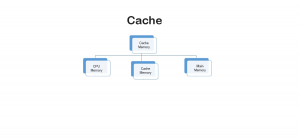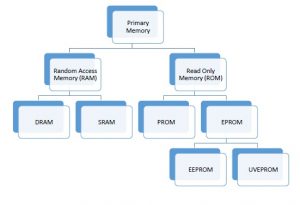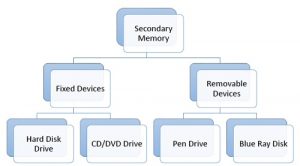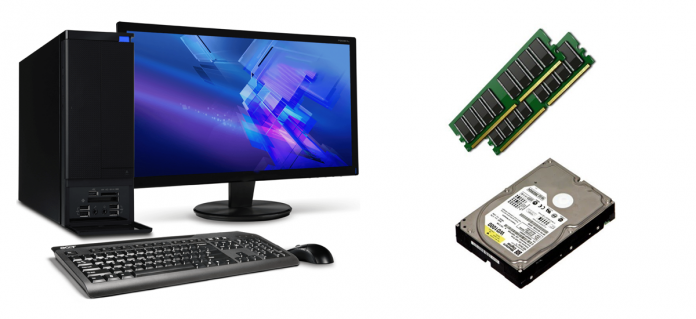A memory is described as a part that is similar to the brain system that allows one to hold up instructions and data. It is considered as the storage house in the system that can easily process the data and instructions that are stored in it. The whole system of memory is divided into small sets of modules that are termed as cells. These cells are located in the memory at a unique address that allows easy storage of data. The total size of the cells is between zero to total size minus one.
Types of Computer Memory
- Cache Memory
- Primary Memory
- Secondary Memory
Also read – Types of computer memory units
-
What is cache memory
 Cache memory is the one type of memory system that has a high speed of superconductor. It helps in enhancing the CPU speed to a top notch. In addition to this, it is an intermediate part for the main memory and CPU. The cache memory stores the data and instruction that are used frequently by a user. It prevents regular transformation with the main memory and the user can fetch data from it at a higher rate. A small part of program or data is stored up in it that allows CPU to access it easily.
Cache memory is the one type of memory system that has a high speed of superconductor. It helps in enhancing the CPU speed to a top notch. In addition to this, it is an intermediate part for the main memory and CPU. The cache memory stores the data and instruction that are used frequently by a user. It prevents regular transformation with the main memory and the user can fetch data from it at a higher rate. A small part of program or data is stored up in it that allows CPU to access it easily.
Types of Cache Memory
- Primary Cache
This memory is located on the processor chip and is small. It is referred to as L1 (level 1) cache. The access time of processor registers and primary cache is comparable. - Secondary Cache
This memory is located between the primary cache and the remaining memory, which is normally located on the processor chip. It is referred to as the L2 (level 2) cache.
There are many advantages of cache system:
- The total time consumed in fetching data from main memory is lower with the cache.
- It is much faster as compared to another mode of memory.
- The data stored in the system is temporary.
- The data and program that are stored in it are executed at a huge level with a short span of time.
In addition to this, it is a system that is more economical when it is compared with the register. It is also the fast memory system that can easily send out the essential data to the customer.
Also read – What is virtual memory and how it works?
-
What is primary or main memory
 Another type of memory is the main or primary Cache memory. It is the memory system that allows storing instruction and data on which the system is working in the present time. The whole system has a limited capacity and when the system is switched off, it lost all the data. You can consider it a temporary memory system. Like cache memory, this is also a device made up of semiconductor and are not fast in comparison to registers. This type of system is divided into two part ROM – Read Only Memory and RAM – Random Access Memory.
Another type of memory is the main or primary Cache memory. It is the memory system that allows storing instruction and data on which the system is working in the present time. The whole system has a limited capacity and when the system is switched off, it lost all the data. You can consider it a temporary memory system. Like cache memory, this is also a device made up of semiconductor and are not fast in comparison to registers. This type of system is divided into two part ROM – Read Only Memory and RAM – Random Access Memory.
RAM is made up of several modules in which the data or instructions are stored up when the system is in running condition. Whereas in ROM, the memory is stored when the whole system is in volatile form. Meaning that when the system is turned off then all the data will be lost. Hence, the system is loaded to RAM or primary memory from secondary memory on the start. This is the same case for any software or application.
The ROM is divided into 4 types:
- MROM (Masked ROM)
- PROM (Programmable ROM)
- EPROM (Erasable and Programmable ROM)
- EEPROM (Electrically Erasable and Programmable ROM)
Whereas, RAM is of two types:
- SRAM (Static RAM)
This memory is volatile in nature and retains content as long as power is supplied,hence named static. - DRAM (Dynamic RAM)
This memory is refreshed continually to maintain the data, hence named dynamic.
The main characteristics of this type of data processing are:
- This type of memory is the working memory that is present in the system.
- It is much faster as compared to secondary memory.
- It is impossible to work on a system without its main memory.
The best part about main memory is that it has a specific location to store the data as per the service and applications.
Also read – what is hard drive on your computer?
-
What is secondary memory
 The last memory system is the concept of secondary memory. It is the non-volatile or external form of a memory system that is much slower than the other two forms. It is the information or data storage cells where data is stored permanently. This memory system doesn’t work directly under the command of CPU. Hence, it has its own routine for input-output data access. In order for CPU to use it, the data is transferred to CPU. This type of memory system is followed by the memory card, DVD, CD-ROM, pen-drive, etc.
The last memory system is the concept of secondary memory. It is the non-volatile or external form of a memory system that is much slower than the other two forms. It is the information or data storage cells where data is stored permanently. This memory system doesn’t work directly under the command of CPU. Hence, it has its own routine for input-output data access. In order for CPU to use it, the data is transferred to CPU. This type of memory system is followed by the memory card, DVD, CD-ROM, pen-drive, etc.
This type of system can have a large amount of storage capacity in comparison to the main memory system. For instance, an external hard disk can be more than 1TB of space whereas the system memory is mainly around 500 GB to 1TB. These type of data stored is in the form of a file that works as per a specific name format. Also, it has large blocks on which the data is stored. These blocks allow the data to be copied and work accordingly.
This type of system is used as the backup memory system. Also, it has optical and magnetic memories on which data is stored. Similarly to the main memory, the data is erased when the system is switched off. However, it is not an essential part for a system and hence a system can work without it.











































